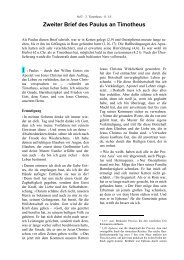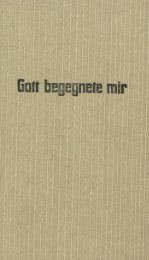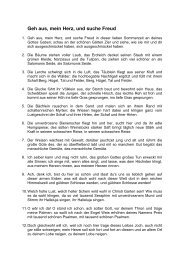Create successful ePaper yourself
Turn your PDF publications into a flip-book with our unique Google optimized e-Paper software.
from the heart via the arteries. The arteries leading<br />
to the body carry oxygenated blood, while the<br />
blood in the veins lacks oxygen. This situation is<br />
reversed for the arteries leading to the lungs and<br />
the veins coming from the lungs.<br />
Although the heart is filled with blood, it still<br />
requires its own blood supply. Situated on the<br />
surface of the heart, the branches of the coronary<br />
arteries penetrate its wall. The coronary<br />
veins collect blood from the capillaries in the<br />
heart muscles and carry it back. This circulatory<br />
route is the shortest in the entire human body.<br />
Looking at the heart from the front, one actually<br />
sees mainly the right ventricle, with the right<br />
atrium above it. Two large veins (the superior and<br />
inferior vena cava; Latin vena = vein, cava = hollow)<br />
empty into the right atrium. The aorta arises<br />
from the left ventricle and arches over the pulmonary<br />
artery issuing from the right ventricle. It<br />
then passes downwards behind the heart.<br />
➔<br />
➔<br />
➔<br />
<br />
➔<br />
➔<br />
➔<br />
<br />
<br />
➔<br />
➔<br />
➔<br />
<br />
<br />
<br />
Aorta<br />
Pulmonary artery<br />
Pulmonary veins<br />
Left atrium<br />
Left ventricle<br />
Inferior vena cava<br />
Right ventricle<br />
Right atrium<br />
Superior vena cava<br />
<br />
➔<br />
<br />
<br />
Anterior view of the contours of the heart and its<br />
associated large blood vessels.<br />
The two halves can be readily distinguished: the right half is<br />
in the foreground, partially concealing the left half.<br />
51
















